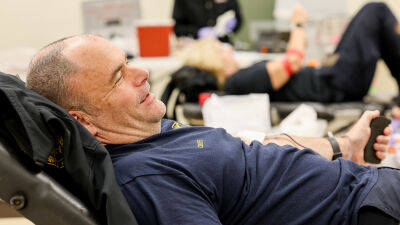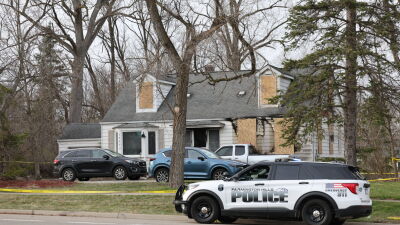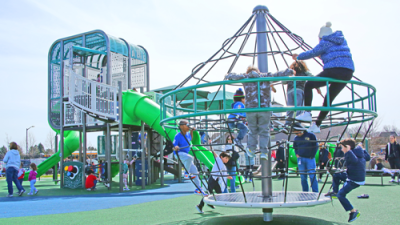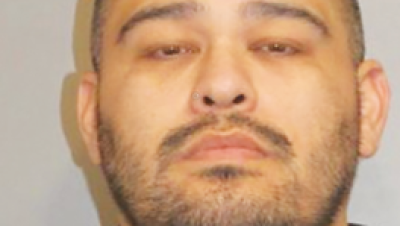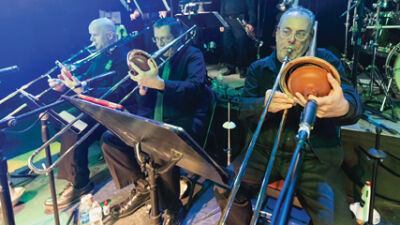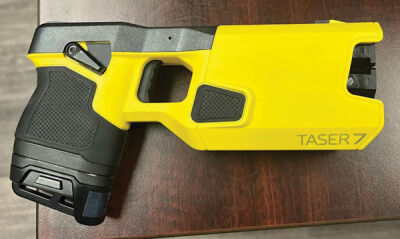
The new Taser 7 features dual cartridges that afford officers with the Eastpointe Police Department a second shot. The device also allows them to display a warning arc. Tasers are meant to safely incapacitate uncooperative subjects with a shock that lasts five seconds.
Photo provided by Alexander Holish
EASTPOINTE — Officers with the Eastpointe Police Department have been issued new Taser models and are currently being trained in their use, something that officials hope will increase safety for both police and the public at large.
Tasers are electrical weapons that can nonlethally subdue an individual threatening harm to the officer, themselves or others. Compared to the old model — the Taser X26 P — the new Taser 7 uses dual cartridges that give officers a second shot if they miss the first one.
According to Eastpointe Police Chief Corey Haines, via email, the Tasers are manufactured by Axon — a company that also makes body cameras and in-car cameras for police cruisers. Axon is leasing 44 Tasers to the EPD — one for each sworn officer — over a five-year period at a total cost of $185,882, with the first year’s payment being $34,318.
The Eastpointe City Council approved the purchase of the new Tasers during adoption of the fiscal year 2024-25 budget back in June.
The chief thanked the council for its support.
“The City Council has been instrumental in providing the Police Department with the tools they need to successfully protect our citizens,” Haines said.
He explained how the Taser 7 is safer and more effective than the prior model.
“Having the second shot may alleviate officers from having to use a firearm or engage in hand-to-hand combat with the suspect,” Haines said. “The Taser 7 is also equipped with a warning arc that allows officers to cycle the weapon without discharging it, in order to gain compliance with an uncooperative suspect.”
He noted that the electrical arc can be shown without officers having to remove the cartridge.
“So if it’s not effective (at intimidating the subject), officers can still use the weapon,” he said.
The chief also explained that the Taser 7 uses “cross-connect technology” where the device continues to measure the connection between the prongs and the target, even when both cartridges are deployed, regulating their electrical output as conditions with the target change.
“This technology allows officers to hit the target with one probe from each cartridge and still incapacitate the suspect,” Haines said.
Tasers are usually deployed to subdue subjects who are actively resisting arrest. Once the suspect is hit with the Taser prongs, they become incapacitated for five seconds. That gives officers an opportunity to handcuff the suspect and make a safe arrest.
Once the five-second Taser cycle has completed, the suspect no longer feels any ill effect.
“The use of the Taser often prevents potential injuries that officers and suspects can sustain during hand-to-hand combat confrontations. It improves officer safety tremendously,” Haines said. “Also, Taser has been known to save lives. Officers will use it to subdue a suicidal subject who is suffering from a mental health crisis.
“Several years ago, I personally used the Taser on a subject who was armed with a knife and wanted to commit suicide,” the chief added. “Without the Taser, I would have been forced to use my firearm (to prevent the suspect from possibly turning the knife on others).”
On rare occasions, Tasers are also used to subdue aggressive dogs so that a dog stick can be placed on them and they can be brought under control.
Tasers are just one of several nonlethal options at an officer’s disposal. Officers also carry pepper spray and are trained in Krav Maga, a form of close quarters combat originally developed by the Israel Defense Forces. But these physical options, Taser included, are only used when warning the suspect doesn’t gain compliance.
“Officers are trained to always try to use verbal de-escalation as the main option,” Haines said. “Unfortunately, sometimes this technique is not effective.”
For training, officers take a class in which they’re shown how to use the new Tasers and their added features. A PowerPoint presentation and two written exams follow the classroom portion. Officers are then taken to the range where they fire the Taser to demonstrate their ability to safely operate and discharge it.
“We are no longer required to be tased as part of training,” Eastpointe Police Detective Lt. Alexander Holish said. “Several years ago, Taser got reclassified from ‘nonlethal weapon’ to ‘less lethal.’ In order to avoid any potential accidents, we stopped tasing officers. Older guys, including myself, have been tased, however. So, I can say that it is a very effective weapon to temporarily incapacitate a human.”
Holish said that police are under extraordinary pressure out in the field, and the Tasers offer great peace of mind.
“Every second can turn deadly, so officers are often using precaution, and unfortunately, the fact of life is that actions are quicker than reactions, so sometimes officers have to make split-second decisions to try and prevent harm to themselves and others. They look for red flags that are displayed by the subject, and we learn to recognize those red flags through our training experience.”
To that end, members of the public should keep certain behaviors in mind when interacting with police officers, especially during a traffic stop.
“Just keep your hands visible. Don’t make sudden movements. Don’t reach under the seat. Obey the officer and ask for what they’d like you to do,” Holish said. “If you feel the officer is wrong, you can always take recourse against them at a later time. There’s no need to turn a simple traffic stop into a confrontation.”
 Publication select ▼
Publication select ▼




